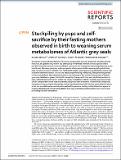Stockpiling by pups and self-sacrifice by their fasting mothers observed in birth to weaning serum metabolomes of Atlantic grey seals
Abstract
During the uniquely short lactations of true seals, pups acquire a greater proportion of maternal body resources, at a greater rate, than in any other group of mammals. Mothers in many species enter a period of anorexia but must preserve sufficient reserves to fuel hunting and thermoregulation for return to cold seas. Moreover, pups may undergo a period of development after weaning during which they have no maternal care or nutrition. This nutritionally closed system presents a potentially extreme case of conflict between maternal survival and adequate provisioning of offspring, likely presenting strains on their metabolisms. We examined the serum metabolomes of five mother and pup pairs of Atlantic grey seals, Halichoerus grypus, from birth to weaning. Changes with time were particularly evident in pups, with indications of strain in the fat and energy metabolisms of both. Crucially, pups accumulate certain compounds to levels that are dramatically greater than in mothers. These include compounds that pups cannot synthesise themselves, such as pyridoxine/vitamin B6, taurine, some essential amino acids, and a conditionally essential amino acid and its precursor. Fasting mothers therefore appear to mediate stockpiling of critical metabolites in their pups, potentially depleting their own reserves and prompting cessation of lactation.
Citation
Watson , D , Pomeroy , P , Al-Tannak , N F & Kennedy , M 2020 , ' Stockpiling by pups and self-sacrifice by their fasting mothers observed in birth to weaning serum metabolomes of Atlantic grey seals ' , Scientific Reports , vol. 10 , 7465 . https://doi.org/10.1038/s41598-020-64488-1
Publication
Scientific Reports
Status
Peer reviewed
ISSN
2045-2322Type
Journal article
Description
The work was funded from core support given to the Sea Mammal Research Unit, Scottish Oceans Institute, from the National Environmental Research Council (UK), and separately by the Universities of Glasgow and Strathclyde. The funding of mass spectrometry equipment for metabolomics was provided by the Scottish Life Sciences Alliance.Collections
Items in the St Andrews Research Repository are protected by copyright, with all rights reserved, unless otherwise indicated.

